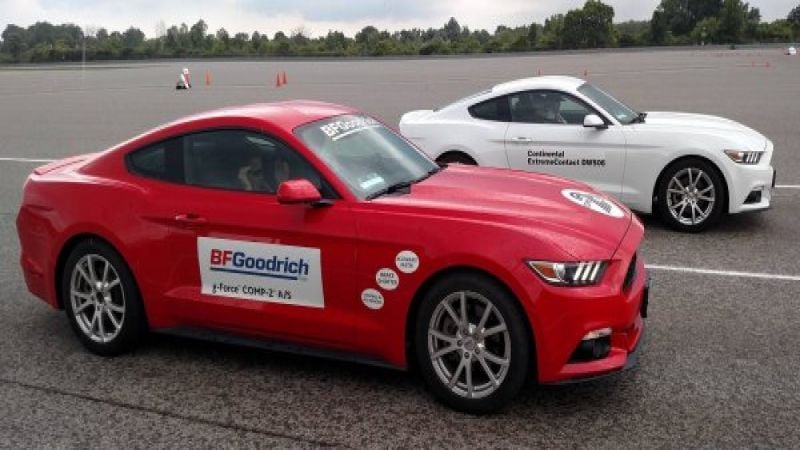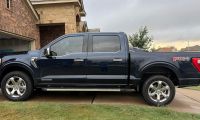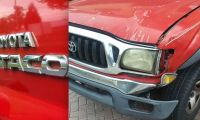While most car enthusiasts who are into going fast understand that better tires can lead to improved performance, it is hard to really understand how big of a difference a simple tire change can make, but thanks to some time on an autocross course with the new Ford Mustang – I was able to experience the vast difference first hand.
Before getting into my seat time in the 2015 Ford Mustang, I want to point out that these tests were conducted as part of a dealer training program held by BFGoodrich. While there were a few members of the media invited, most of the participants worked at local tire stores and they were there to learn more about tire construction and how design leads to a better tire. The technical portion of the event is far more of a benefit to those folks selling tires and the intricate details of tire design will likely be lost of many people, but the head to head tire tests on the autocross are far easier to interpret.
BFGoodrich VS Continental in the Ford Mustang
BFGoodrich had a pair of equally equipped 2015 Ford Mustang fastbacks with the 300hp V6 engine and an automatic transmission. Both cars had aftermarket wheels, with the red car sporting BFGoodrich g-Force Comp-2 A/S tires while the white car was fitted with Continental ExtremeContact DSW06 tires. These particular Continental tires were chosen by the group of dealers in attendance as what they considered to be the most likely tire to be cross-shopped against the BFG tire.
A team of professional drivers was on hand to assist us in making the most of our track time, but they didn’t offer a whole lot of what to expect before we climbed into each Ford Mustang. The instructors rode along, giving us pointers and advice along the way, and while the course was simple – it did a great job of pushing the tires to their limits.
The track began with the Mustang at a stop and we were instructed to launch hard and accelerate until we hit around 50 miles per hour, at which point we were to slam on the brakes. We then took a sweeping left, a series of s-turns, another sweeping turn, a hard lane change and a long, sweeping right. It was short and sweet, with some tight turns, some faster turns and some hard back-and-forth.
We started with the Mustang fitted with the BFGoodrich tires and throughout the course, the V6 pony car performed pretty well. While this was the “base model” Mustang, it packs enough power to test the tires on the hard stop and when powering through (or out of) turns. On my second lap with the BFG tires, I was able to get through the course a little more quickly as I became familiar with the layout and the car.
I then moved to the white Ford Mustang, which was fitted with the Continental tires. There was no real difference on the launch, but when I hit the hard braking zone, the white car took significantly further to stop. As I entered the essess, I quickly found that the front end was harder to control as I cut back and forth, and with each turn, there was more slide – eventually causing the back end to dance out a little. The other most noticeable difference came on the long, final turn, where the back end of the car wanted to slide out as I neared the finish line.
Even on the second pass with the Continental tires – after I had gotten a feel for the Mustang with those tires on that track – I found myself chasing the car around when I tried to hurry through the turns.
The two videos below show the Ford Mustang in action on the autocross course, with the first video showing the BFGoodrich-equipped car while the white Mustang had the Continental tires. While you cannot feel the car sliding around, you can clearly see how much more the white Mustang slides around in the turns.
While the idea of this program was to show dealers how the BFGoodrich tires were better than the Continental tires, what was most interesting to me was how much of a difference it made in the handling and braking performance of the 2015 Ford Mustang. Mind you, we aren’t talking about going from a stock street tire to a purpose built performance tire, nor are we talking about jumping up to a far more expensive tire. In fact, the Continental tires on average cost around 4% more than the BFG tires and they are both all-season tires - yet the g-Force Comp-2 A/S proved to be the better performing of the two options.
This should serve as a reminder to everyone who wants the best possible performance from their vehicle that even on a mild performance car like the base model Ford Mustang – the right tire choice can go a long way in making your car more fun to drive and more capable in key driving situations.













Comments
What I want to know is the
Permalink
What I want to know is the wear index of both tires. A stickier compound will improve traction but the useful mileage life will be greatly reduced. There are huge differences in tires but there is a bit more to the story.
I run Conti's on mt BMW 528i sport. I have done familiarization laps at 4 or 5 tracks in the car. It is a great tire. I will probably get 35m miles + if I drive normally. My old BMW M-5 had far superior super whoopie Dunlops. I really didn't drive it all that hard. 15,000 miles was about all they were worth.
Find me a tire dealer that wants a customer walking in with less than 25,000 with blown out tires.
My point is all tires are compromises. This comparison showed one that excells at a specific task.
I am sure Consumers Digest would have a different opinion.